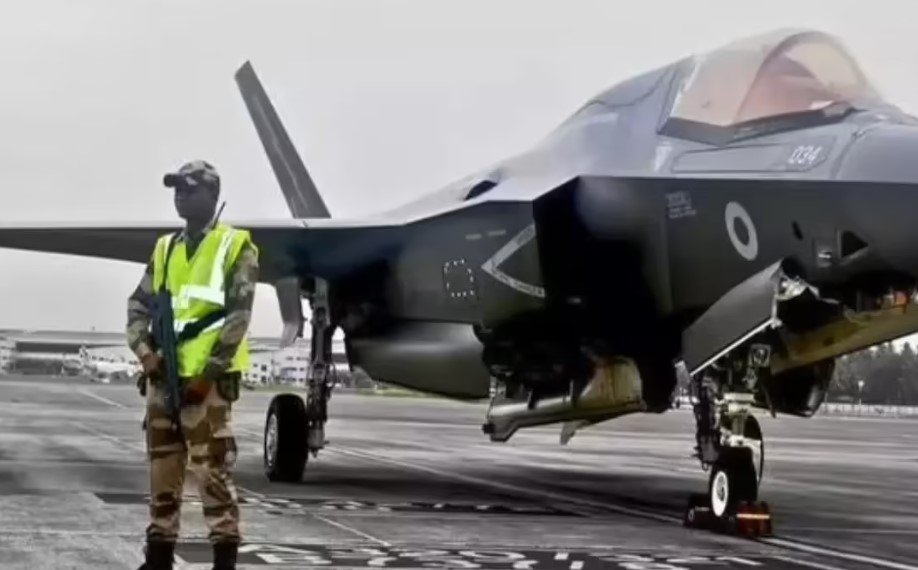British stealth jet stuck at Kerala airport sparks classified tech concerns, diplomatic whispers
A British Royal Navy F-35B Lightning II fighter jet has been grounded at an Indian airport for more than ten days, igniting unease over the safety of its highly classified systems and sparking curiosity across military and diplomatic circles.
The £80 million stealth aircraft, part of the UK’s prized air fleet onboard the HMS Prince of Wales, was forced to make an emergency landing at Thiruvananthapuram International Airport on 14 June after it hit heavy weather off India’s southern coast. But what started as a precautionary detour is now spiraling into something a lot thornier.
A Lightning Jet Lands—And Doesn’t Take Off Again
The jet was mid-sortie, flying roughly 100 nautical miles southwest of Kerala when visibility and conditions worsened. Unable to return to the aircraft carrier stationed in the Indian Ocean, the pilot requested to land at the nearest major airstrip—Thiruvananthapuram.
India’s Air Force confirmed the emergency diversion. They said the aircraft was flying outside of India’s Air Defence Identification Zone and had been “earmarked as the emergency recovery field” in advance. Basically, it was a known backup option.
But that’s where the predictability ended.

Why the Royal Navy Won’t Move the Jet
Here’s the awkward part. According to reports from NDTV and security sources, Indian authorities offered to tow the F-35B into a hangar for protection from the tropical rains. The Royal Navy politely—or maybe not so politely—declined.
And the reason? The British are worried. Very worried.
Apparently, they’re deeply protective of the F-35B’s stealth systems and avionics. These aren’t everyday parts. The aircraft is packed with tech that’s highly restricted under NATO protocols and U.S.-UK defense agreements.
So, any prolonged exposure—even under tarps—risks the jet becoming a curiosity magnet. Not just for Indian officials, but potentially for intelligence-gathering rivals.
Is This a Security Risk or a Diplomatic Test?
For New Delhi, the F-35B’s unplanned visit is both an opportunity and a dilemma. India is not an adversary, of course. But it’s not part of NATO either, and the presence of a stealth jet on Indian soil naturally opens the door to a hundred questions.
Could sensor sweeps be run from nearby radars? Are there ways to observe emissions or stealth signature without touching the plane? Probably. Would India do it? Unknown.
And what about China or Russia? Experts quietly warn that local surveillance infrastructure could relay signals of interest to third parties. Some defense analysts call that “passive collection.” Others call it good old-fashioned spying.
It’s not paranoia if you’re flying an £80 million flying computer.
The Jet’s Secrecy Isn’t Just Theoretical
There’s precedent here. The F-35’s classified design files have been targeted before. In 2009, reports surfaced that Chinese hackers breached U.S. systems and accessed terabytes of data related to the program’s stealth capabilities.
Since then, the jet’s tech has become something of a holy grail for foreign intelligence services.
That’s why every move around the grounded plane is under scrutiny.
Here’s the core worry in practical terms:
| Feature of F-35B | Security Sensitivity | Risk Level if Exposed |
|---|---|---|
| Radar-absorbing materials | Highly classified | High |
| Electronic warfare systems | Joint NATO protocols | Very High |
| Mission data files | US-UK restricted access | Critical |
| Autonomic logistics system | Cloud-based, encrypted | Medium-High |
Local Curiosity, Global Implications
On the ground in Kerala, the aircraft’s presence hasn’t gone unnoticed. Locals spotted it covered in temporary canopies, flanked by a ring of armed security. Social media posts were deleted just as quickly as they went up.
There’s a quiet dance unfolding behind the scenes. UK engineers have reportedly flown into the city. So have personnel from Lockheed Martin, the jet’s manufacturer. No one’s confirming it, but they’re likely running diagnostics and prepping for a tightly choreographed extraction.
And that raises another question: How do you safely lift an elite stealth jet off foreign soil without drawing even more attention?
One option floated involves partially disassembling the aircraft and flying it back in a military transport. But that’s a complex operation, both technically and diplomatically.
Timing Couldn’t Be Trickier for London and Delhi
The jet’s unexpected layover comes as the UK is ramping up defense procurement and deepening military ties with the U.S., including a new order for 12 additional F-35s.
For India, meanwhile, the incident arrives at a moment of transition. With a new government recently re-elected and its own military modernization plans under way, hosting one of the world’s most advanced aircraft—even temporarily—has symbolic weight.
But too much curiosity could quickly become a liability.
And the longer the F-35 stays put in Kerala, the higher the stakes climb.








